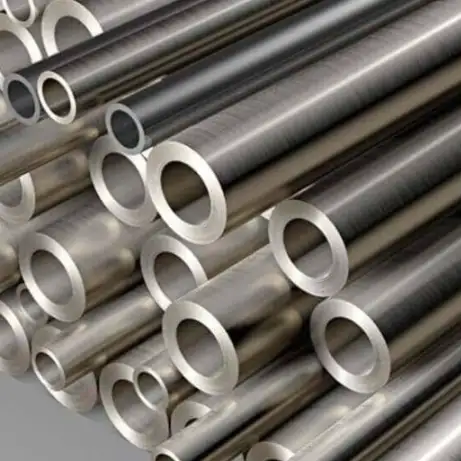The precipitation-hardening martensitic alloy 630 (17-4PH) combines high strength, excellent corrosion resistance and good machinability in a readily weldable grade. Its balanced properties make it ideal for shafts, valves, aerospace components and oil-field equipment. For competitively priced, customizable stock and rapid delivery, Luokaiwei in China offers genuine factory pricing, tailored heat treatments and on-hand bar, plate and forging inventories.
1. Nomenclature and International Designations
630 stainless steel is officially designated SAE Type 630 and UNS S17400. In European standards it appears as X5CrNiCuNb16-4 (EN 10088-3), and under ASTM it’s referenced in A564/A564M for bars and forgings. The common trade name “17-4PH” refers to ~17% chromium, ~4% nickel with precipitation-hardening copper additions.
2. Chemical Composition
Typical composition ranges:
- Carbon: ≤0.07%
- Chromium: 15.0–17.5%
- Nickel: 3.0–5.0%
- Copper: 3.0–5.0%
- Niobium+Tantalum: 0.15–0.45%
Minor Mn, Si, P, S. These elements yield a martensitic matrix capable of age hardening.
3. Metallurgical Structure
In the solution-treated Condition A, 17-4PH is a soft martensite. Controlled ageing at 480–620 °C precipitates fine copper-rich phases, boosting yield and ultimate tensile strengths to H900 through H1150 conditions. Over-ageing beyond 620 °C may reduce hardness for improved toughness.
4. Mechanical Properties
| Condition | Tensile (MPa) | Yield 0.2% (MPa) | Elongation (%) | Hardness (HRC) |
|---|---|---|---|---|
| Solution (A) | 1000 typ. | 800 typ. | 15 typ. | ≤38 |
| H900 (482 °C×1 h) | ≥1310 | ≥1170 | ≥10 | ≥40 |
| H1150 (621 °C×4 h) | ≥930 | ≥724 | ≥16 | ≥28 |
Values per ASTM A564; specific properties vary with section size and heat-treatment control.

5. Physical and Thermal Characteristics
- Density: 7.75 g/cm³
- Modulus of Elasticity: 197 GPa
- Thermal conductivity: ~10.8 W/m·K (0–100 °C)
- Coefficient of thermal expansion: 10.8–11.6 µm/m·°C (0–100 °C)
These ensure dimensional stability in moderate-temperature applications up to ~300 °C.
6. Corrosion Resistance
Comparable to 304 stainless, 17-4PH resists general corrosion in mild environments. Copper additions enhance resistance to stress-corrosion cracking. Prolonged exposure to chloride-rich or high-temperature (≥370 °C) service requires protective measures or alternative alloys.
7. Heat-Treatment Processes
- Solution Treatment (Condition A): 1040 °C×0.5 h, air cool to <30 °C.
- Age Hardening: Typical cycles:
- H900: 482 °C×1 h → air cool
- H1025: 525 °C×4 h → air cool
- H1150: 620 °C×4 h → air cool
Shrinkage is minimal (<0.1%), preserving dimensional accuracy for precision components.
8. Machining and Fabrication
In Condition A, 17-4PH machines similarly to 304 grades. Carbide tooling and moderate speeds limit work-hardening. Post-machining ageing yields final mechanical properties. Luokaiwei offers pre-aged and solution-treated bar to streamline customer workflows.
9. Welding Recommendations
All conventional welding (GTAW, GMAW) suits 17-4PH without preheating. Use compatible filler (17-7PH or matching 630) and post-weld ageing to restore strength in weld zones. Controlled interpass temperatures (<150 °C) prevent martensite embrittlement.
10. Applications across Industries
- Oil & Gas: Valve components, pump shafts, frac hardware
- Aerospace: Turbine blades, seal rings, landing gear fittings
- Chemical Processing: Mixer shafts, reactor liners
- Power Generation: Nuclear waste casks, steam turbine parts
- General Engineering: Moulds, high-strength fasteners.
11. Standards and Specifications
Key documents include:
- ASTM A564/A564M (bars, forgings)
- ASTM A693 (plates)
- EN 10088-3 (European chemical composition)
- UNS S17400 (UNS registry)
- ISO 15510 (general stainless steel classification).
12. Alternative Alloys and Comparisons
| Alloy | Key Difference |
|---|---|
| 431 | Better toughness, lower strength |
| 630 vs 304 | ~2× strength post-age |
| 17-7PH | Higher toughness at moderate strength |
| 2507 duplex | Superior corrosion, lower density |
Select based on strength, corrosion and fabrication needs.
13. Global Market Pricing Comparison
| Region | Form | Price (USD/kg) |
|---|---|---|
| China | Round bar | 6.0–7.5 |
| India | Round bar | 7.0–8.5 |
| USA | Round bar | 15.0–18.0 |
| Europe | Round bar | 14.0–16.0 |
Luokaiwei leverages 100% factory-direct pricing to undercut these averages, offering custom sizes at Chinese domestic costs with rapid stock shipping.
14. Luokaiwei: Your 630 Stainless Partner
Based in China, Luokaiwei supplies genuine 630/17-4PH bar, plate and forgings. Advantages:
- Factory-direct pricing (no middlemen)
- Custom machining & heat-treatment services
- Fast dispatch on stocked items
- Full compliance with ASTM, EN and ISO standards
- Technical support from in-house metallurgists
15. Sustainability and Recycling
17-4PH is fully recyclable. Scrap recovery in modern mills reclaims chromium and nickel, supporting circular manufacturing and reducing environmental impact.
FAQs
1. What is the maximum service temperature for 630 stainless steel?
Recommended up to ~300 °C. Extended exposure above precipitation-hardening temperatures (~480–620 °C) can reduce toughness.
2. Can 630 stainless be formed cold?
Minor cold bending is possible in Condition A, but extensive forming is discouraged due to martensitic hardening.
3. How does ageing temperature affect properties?
Lower ageing (H900) yields highest strength; higher ageing (H1150) improves ductility at some strength loss.
4. Is 630 suitable for marine environments?
Mild seawater is acceptable, but more aggressive chloride service often requires duplex or superaustenitic grades.
5. What tolerances are available?
Luokaiwei stocks to ASTM A564 tolerances for bars; custom CNC turning held to ±0.01 mm.











